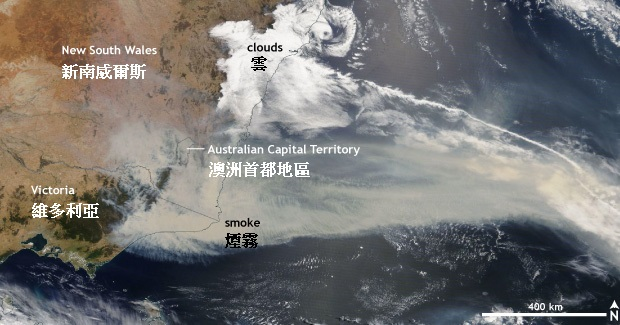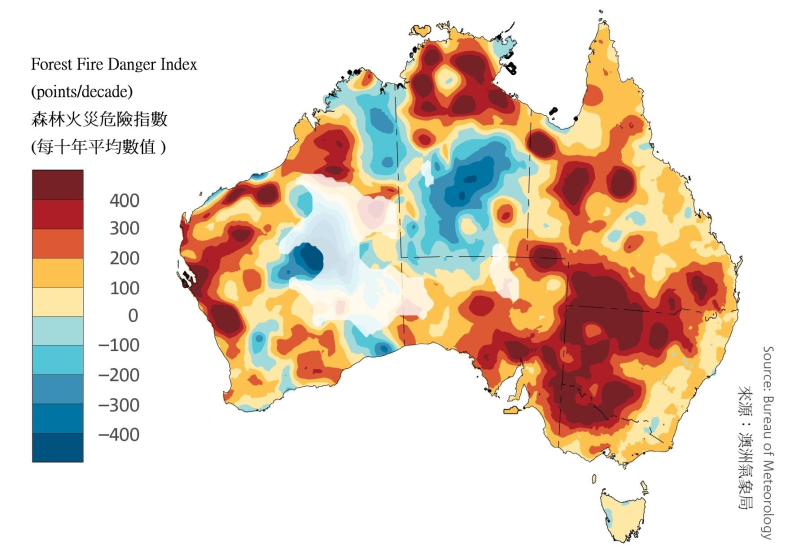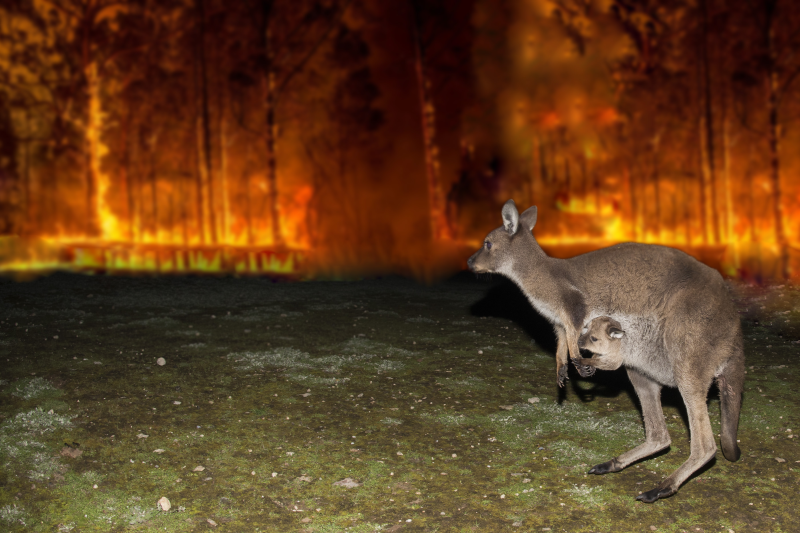Endless wildfires
Endless wildfires
SHAM Fu-cheung
June 2020
According to the analysis of the World Meteorological Organization, This link will open in a new window2019 was the second warmest year on record globally, with the past five years, 2015-2019, being the five warmest on record. Under global warming, extreme hot weather events ravaged different parts of the world. For example, Australia registered the hottest summer on record between the end of 2018 and early 2019. In December 2019, a high temperature near 50°C was recorded in southern Australia. Europe could not be spared and was hit by heatwaves twice within a month between late June and late July 2019. In the first heatwave, This link will open in a new windowFrance registered a record breaking temperature of 46°C. The second heatwave was more pervasive, breaking high temperature records in This link will open in a new windowGermany, the Netherlands, Belgium, Luxembourg and the United Kingdom. During the two heatwaves, more than 1,400 excess deaths as compared with the average were observed in affected regions.
Very often, hot weather is accompanied by wildfires (also known as bushfires and forest fires), especially in dry environment. In June 2019, This link will open in a new windowmore than a hundred intense and long-lived wildfires occurred in the Arctic Circle. In the same year, the Amazon forest experienced the This link will open in a new windowmost active fire season since 2010. Yet, the most significant wildfire in 2019 was the Australian bushfires which occurred in the second half of the year. The bushfires began in Queensland in September 2019, spreading south to New South Wales and Victoria (Figure 1), and gradually became under control in March 2020. This link will open in a new windowThe bushfires have killed many people, destroyed hundreds of homes and burned large areas of land, causing massive devastation to ecosystems and the environment. Analyses showed that This link will open in a new windowthe bushfires had burned 21 per cent of Australia’s forests, far exceeding similar records in other continents over the past 20 years. In addition, scientists estimated that This link will open in a new window800 million animals were killed by the fires in New South Wales alone, and the total number of animals killed exceeded 1 billion for the whole nation.
Is this extreme bushfire event a random event, or its chance of occurrence has been enhanced by climate change? We can get some clues from the This link will open in a new windowclimate report published by the Bureau of Meteorology, Australia. The temperature of Australia has risen by 1°C since 1910, leading to an increase in the frequency of extreme heat events. In southeastern Australia, there has been a decline of around 11% of April-October rainfall since the late 1990s, and there is a long-term increasing trend in the Forest Fire Danger Index (Figure 2). This link will open in a new window2019 was the warmest and driest year on record for Australia, setting the scene for the bushfires. In fact, many studies have pointed out the link between climate change and Australian bushfires. For instance, This link will open in a new windowclimate change made the 2018 Queensland bushfires four times more likely; and This link will open in a new windowclimate change will make firestorms more likely in southeastern Australia.
In light of the Australian bushfires, scientists have reviewed recent research results and drawn the conclusion that This link will open in a new windowhuman-induced climate warming has already led to a global increase in the frequency and severity of fire weather, increasing the risks of wildfire. Wildfires not only pose direct threat to lives and properties but also release pollutants detrimental to human health and ecosystems (Figure 3). In addition, carbon dioxide released by wildfires exacerbates the greenhouse effect. Natural factors that trigger wildfires (e.g. lightning) are beyond human control. However, reducing greenhouse gas emissions to mitigate climate change impact could be under human's control. The threats of climate change on the human daily lives and the ecosystems are imminent. We must make every effort to combat climate change proactively.

Figure 1. A river of smoke from bushfires in Victoria and New South Wales, Australia, on 2 January 2020. (Source: National Aeronautics and Space Administration, US)

Figure 2. Trends from 1978 to 2017 in the annual sum of the daily Forest Fire Danger Index. Positive trends are indicative of an increasing length and intensity of the fire weather season. (Source: Bureau of Meteorology, Australia)

Figure 3. Wildfires devastating ecosystems.





 Local Weather
Local Weather Weather Forecast
Weather Forecast Weather Warnings
Weather Warnings Weather for Fishermen
Weather for Fishermen Weather for Marine
Weather for Marine Weather for Aviation
Weather for Aviation Weather Monitoring Imagery
Weather Monitoring Imagery GIS Weather Service
GIS Weather Service Tropical Cyclone
Tropical Cyclone China Weather
China Weather World Weather
World Weather Climate Information Service
Climate Information Service Warnings & Signals Database
Warnings & Signals Database Statistics of Special Weather Events
Statistics of Special Weather Events Monthly Weather Summary
Monthly Weather Summary Climate Change
Climate Change El Nino and La Nina
El Nino and La Nina Earthquakes
Earthquakes Tsunamis
Tsunamis Tide
Tide Geomagnetism
Geomagnetism Space Weather
Space Weather Weather Information for Astronomical Observation
Weather Information for Astronomical Observation Interactive Sun Path Diagram
Interactive Sun Path Diagram Astronomical Data
Astronomical Data Interesting Astronomical Phenomena
Interesting Astronomical Phenomena Time Services
Time Services Calendar
Calendar Almanac
Almanac Real time Radiation level in Hong Kong
Real time Radiation level in Hong Kong Understanding Radiation
Understanding Radiation Radiation Monitoring, Assessment and Protection
Radiation Monitoring, Assessment and Protection Environmental Radiation Monitoring Programme
Environmental Radiation Monitoring Programme Daya Bay Contingency Plan
Daya Bay Contingency Plan Related Sites
Related Sites Schools
Schools Travel
Travel Sports
Sports Outdoor Photography
Outdoor Photography CWOS
CWOS Senior Citizens
Senior Citizens Stargazers
Stargazers FoOb
FoOb My Little Observatory
My Little Observatory Educational Resources
Educational Resources 360 Tour of HKO
360 Tour of HKO Cloud Appreciation by Dr Tin
Cloud Appreciation by Dr Tin International Cloud Atlas
International Cloud Atlas Guided Tour
Guided Tour Courses and Activities for the Public
Courses and Activities for the Public Subscription of e-Bulletins
Subscription of e-Bulletins Research Forum
Research Forum Publications
Publications International Atomic Energy Agency
International Atomic Energy Agency Regional Specialized Meteorological Centre for nowcasting
Regional Specialized Meteorological Centre for nowcasting Asian Aviation Meteorological Center
Asian Aviation Meteorological Center Social Media
Social Media Press Releases
Press Releases What's New
What's New HKO Updates
HKO Updates LegCo Questions and Answers
LegCo Questions and Answers Observatory's Blog
Observatory's Blog Weather On-Air
Weather On-Air Cool Met Stuff
Cool Met Stuff Central Briefing
Central Briefing Tropical Cyclone Report Broadcast
Tropical Cyclone Report Broadcast Observatory's News
Observatory's News Vacancies
Vacancies Tender Notices
Tender Notices Apps
Apps Personalized Website
Personalized Website Weather Wizard
Weather Wizard Weather Information in Text
Weather Information in Text Weather Information in RSS
Weather Information in RSS Audio Web Page
Audio Web Page Forms
Forms Open Data
Open Data HKO Corporate Video
HKO Corporate Video Vision and Mission
Vision and Mission Organizational Structure
Organizational Structure Quality Management
Quality Management Hong Kong Observatory – The Facts
Hong Kong Observatory – The Facts Hong Kong Observatory 2024
Hong Kong Observatory 2024 Our Services
Our Services Programme Areas of the Observatory
Programme Areas of the Observatory History of the Hong Kong Observatory
History of the Hong Kong Observatory Career@HKO
Career@HKO Visitors Figures
Visitors Figures











